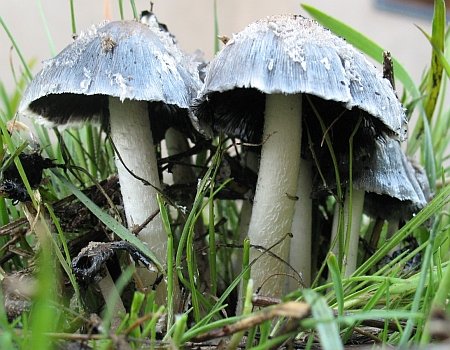Coprinopsis cinerea (Schaeff).
Synonyms
Agaricus cinereus Schaeff.
Fung. Bavar. Palat. 4: 100 (1774)
Agaricus cinereus Schaeff.
Fung. Bavar. Palat. 4: 100 (1774) var. cinereus
Agaricus cinereus var. macrorhizus (Pers.) Fr.
Syst. mycol. (Lundae) 1: 311 (1821)
Agaricus macrorhizus Pers.
Syn. meth. fung. (Göttingen) 2: 398 (1801)
Agaricus radians Batsch
Elench. fung. (Halle): 61 (1783)
Agaricus stercorarius Bull.
Hist. Champ. France (Paris): 398, tab. 68; 542:2 (1792)
Coprinus cinereus (Schaeff.) Gray
Nat. Arr. Brit. Pl. (London) 1: 634 (1821)
Coprinus delicatulus Apinis
Trans. Br. mycol. Soc. 48: 653 (1965)
Coprinus fimetarius sensu auct. brit.
fide Checklist of Basidiomycota of Great Britain and Ireland (2005)
Coprinus fimetarius var. cinereus (L.) Fr.
Epicr. syst. mycol. (Upsaliae): 246 (1838)
Coprinus fimetarius var. macrorhizus (Pers.) Sacc.
Syll. fung. (Abellini) 5: 1087 (1887)
Coprinus macrorhizus (Pers.) Rea
Brit. basidiomyc. (Cambridge): 503 (1922)
Like many other species originally in genus Coprinus, Coprinopsis cinera was transferred when the genus was divided based on phylogenetic analyses of molecular data (Redhead et al., 2001).
Common names
Wooly cap
Inky cap
Description
Cap: 0.5-2 cm in diameter, conical to ovoid in shape and covered with white floccose or fibrillose tufts of ‘hairs’ when young, expanding to conical or campanulate; grayish-brown or brown in color, margin grey; becoming glabrous with age.
Gills: free, crowded, narrow, white or grey then becoming black in age.
Stem: 0.5-1.5 cm tall x 3-4 mm (apex) to 5-10 mm (base), tapering downwards with a rooting base in the ground, fibrillose, white.
Spore print: black.
Spores: ellipsoid or ovoid in shape, with rounded base and apex, and central, approximately 1.3-1.5 µm wide germ pore, dark red-brown under microscope; 8.5-12 x 6-8 µm,
Edibility: edible.
Habitat: commonly found in dung or wood chips.
The ease of laboratory culture and the relatively short duration of its life cycle have made C. cinerea popular for a variety of genetic investigations (Kamada, 2002).
Bioactive compounds
Galectins (β-galactoside-binding lectin) have been isolated from C. cinerea, the first of this lectin family to be found outside of the animal kingdom (Cooper et al., 1997). These galectins, termed Cgl-1 and Cgl-2, have since been purified and crystallized (López-Lucendo et al., 2004).
Medicinal properties
Antitumor effects
Polysaccharides extracted from the mycelial culture of Coprinopsis cinerea (as Coprinus macrorhizus) and administered intraperitoneally into white mice at a dosage of 300 mg/kg inhibited the growth of Sarcoma 180 and Ehrlich solid cancers by 75% and 80%, respectively (Ohtsuka et al., 1973).

My name is Austin Collins.
I've dedicated my life to Mushrooms.
I believe Mushrooms are the best kept secret when it comes to health and well being.
For that reason, I would like to share a company with you that in my opinion makes the best mushroom products on the market.
The company is called Noomadic Herbals, my favorite supplement they make is called "Mushroom Total".
I take their products every day and they have helped me think better and have more energy. Give them a try.
-Austin
Links
References
Cooper DN, Boulianne PR, Charlton S, Farrell EM, Sucher ALBC.
Fungal galectins, sequence and specificity of two isolectins from Coprinus cinereus.
J Biol Chem. 1997 272:1514-1521.
Kamada T.
Molecular genetics of sexual development in the mushroom Coprinus cinereus.
Bioessays. 2002 24(5):449-59.
López-Lucendo MF, Giménez-Gallego G, Cooper DN, Gabius HJ, Romero A.
Gene design, expression, crystallization and preliminary diffraction analysis of two isolectins from the fungus Coprinus cinereus: a model for studying functional diversification of galectins in the same organism and their evolutionary pathways.
Acta Crystallogr D Biol Crystallogr. 2004 60(Pt 4):721-4.
Ohtsuka S, Ueno S, Yoshikumi C, Hirose F, Ohmura Y, Wada T, Fujii T, Takahashi E.
Polysaccharides having an anticarcinogenic effect and a method of producing them from species of Basidiomycetes.
UK Patent 1331513, 26 September 1973.
Redhead SA, Vilgalys R, Moncalvo J-M, Johnson J, Hopple JS Jr.
Coprinus Pers. and the disposition of Coprinus species sensu lato.
Taxon 50(1):203-241.





Coprinopsis cinerea Need to get my hands on these genetics. Any way I could purchase?
Not that I know of! The hunt is half the fun!